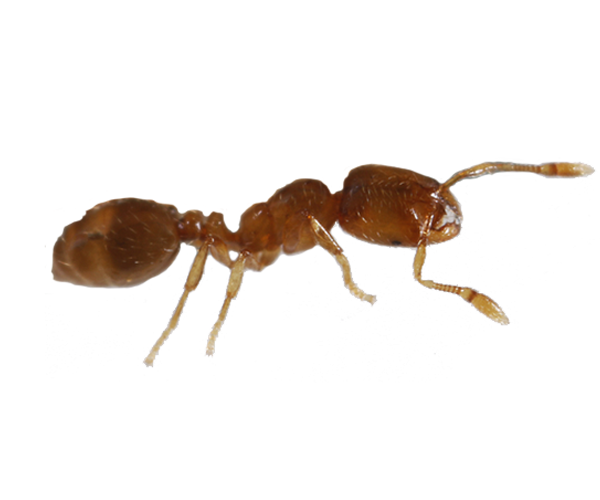Thief Ant
Thief ants are commonly confused with the pharaoh and pavement ant. It is imperative that this type of ant is positively identified by a Pest Management Professional to ensure proper treatment methods, as it does vary from a typical ant treatment.
Thief ants are treated with professional ant baits as well as a non-repellent dust insecticide. Several applications may be required. If the wrong treatment method is used, it can cause the thief ant colony to split and create multiple colonies, making treatment more complex.
How to Get Rid of Thief Ants

A full interior and exterior treatment consist of a visual inspection of “hot spot” areas, treatment of cracks and crevices, wall voids, attics, crawl spaces, window and door frames, baseboards, electrical outlets, pipe chases, decking, tree bases and stumps, and perimeter of the structure.
Suggestions will also be made for control measures such as removing overhanging tree limbs, dead tree stumps, sealing gaps and cracks, etc. Bait and dust are a typical treatment for thief ants and requires multiple visits, 2 weeks apart from our licensed pest control technicians. If the colony has not been eradicated at the time of treatment, generally within 2 weeks they should be dead.
Unfortunately, there is no warranty available as the treatment is designed to allow the ants to ingest the insecticide and also carry it back to the remainder of the colony. This can take as little as 2 service calls and as many as 6 or more.
We recommend all occupants, including pets, vacate the premises for a minimum of 4 hours. Children under 1 year and pregnant women, we recommend 24 hours.
Each year after the initial treatment, Miller Pest Control highly recommends having an exterior preventive treatment. This treatment will help reduce the risk of re-infestation on the interior of the structure and re-guarantees the original interior work.
How to Identify a Thief Ant Infestation
Thief ants are the smallest household ant. These tiny ants that have two nodes between the thorax and the abdomen. They are easily confused with pharaoh ants and the important distinguishing feature is the antenna that have 10 segments ending in a 2-segmented club.
- Colour: Yellow or light brown
- Size: Approximately 0.5 -3 mm long
Although thief ants are very small, their infestations are noticeable. This species is also known to leave trails from a food source to their nest. You may also come across the small ants in your food or cooking ingredients. Once they get inside, these intruders are commonly found foraging for food in kitchens, nesting in small spaces like cabinet voids and wall crevices, as well as behind baseboards and underneath countertops.
How to Prevent a Thief Ant Infestation
- Sealing openings around doors, windows and your foundation.
- Trimming overhanging trees can help reduce access to your home.
- Keep food preparation areas and floors clear of crumbs
Possible Health Concerns
Thief ants do not bite and rarely use their stingers. They may pick up and transfer pathogens to human food after feeding on dead rodents. Because of their small size, they can make their way into packaged foods and are hard to remove without professional help.
About Thief Ant
Thief ants (Solenopsis molesta) get their names from their habit of nesting close to other ant nests and stealing their food. They are also called grease ants because they are attracted to grease.
Their habitat is vast, because they can survive just about anywhere. Their nests are relatively large for their size have tunnels that lead to another ant colony for a reliable and steady food source.
They usually nest under rocks, in any exposed soil, or rotting logs. If they cannot find any of these things, then they move into another colony. They can live in people’s homes, in the cracks or under the floorboards. They can build nests anywhere, but usually near the nests of other species, they steal from.

